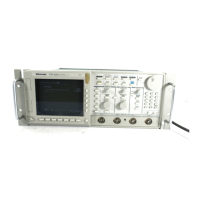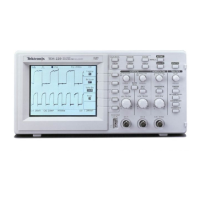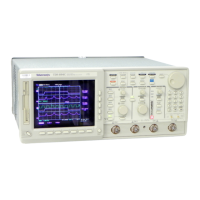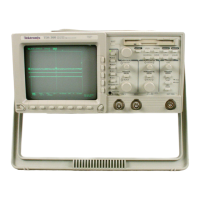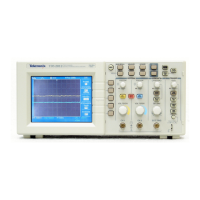Triggering on Waveforms
3–74
TDS 500B, TDS 600B, & TDS 700A User Manual
Table 3–8: Pulse Trigger Definitions
Name Definition
Glitch positive Triggering occurs if the oscilloscope detects positive spike
widths less than the specified glitch time.
Glitch negative Triggering occurs if the oscilloscope detects negative spike
widths less than the specified glitch time.
Glitch either Triggering occurs if the oscilloscope detects positive or
negative widths less than the specified glitch time.
Runt positive Triggering occurs if the oscilloscope detects a positive pulse
that crosses one threshold going positive but fails to cross a
second threshold before recrossing the first going negative.
Runt negative Triggering occurs if the oscilloscope detects a negative
going pulse that crosses one threshold going negative but
fails to cross a second threshold before recrossing the first
going positive.
Runt either Triggering occurs if the oscilloscope detects a positive or
negative going pulse that crosses one threshold but fails to
cross a second threshold before recrossing the first.
Width positive Triggering occurs if the oscilloscope finds a positive pulse
with a width between, or optionally outside, the user-speci-
fied lower and upper time limits.
Width negative Triggering occurs if the oscilloscope finds a negative pulse
with a width between, or optionally outside, the user-speci-
fied lower and upper time limits.
Slew positive Triggering occurs if the oscilloscope detects a positive
pulse edge that after first crossing the lower threshold then
crosses the upper threshold. The pulse must travel
between the two levels at a rate faster or slower than (user
specifies) the user-specified slew rate for triggering to
occur.
Slew negative Triggering occurs if the oscilloscope detects a negative
pulse edge that after first crossing the upper threshold then
crosses the lower threshold. The pulse must travel between
the two levels at a rate faster or slower than (user
specifies) the user-specified slew rate for triggering to
occur.
Slew either Triggering occurs if the oscilloscope detects a positive or
negative pulse edge that first crosses one threshold and
then crosses the other threshold. The pulse must travel
between the two levels at a rate faster or slower than (user
specifies) the user-specified slew rate for triggering to
occur.
Timeout stays high Triggering occurs if the signal stays higher than the trigger
level for longer than the timeout value.

